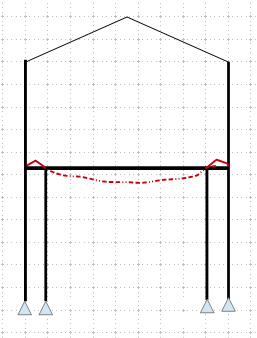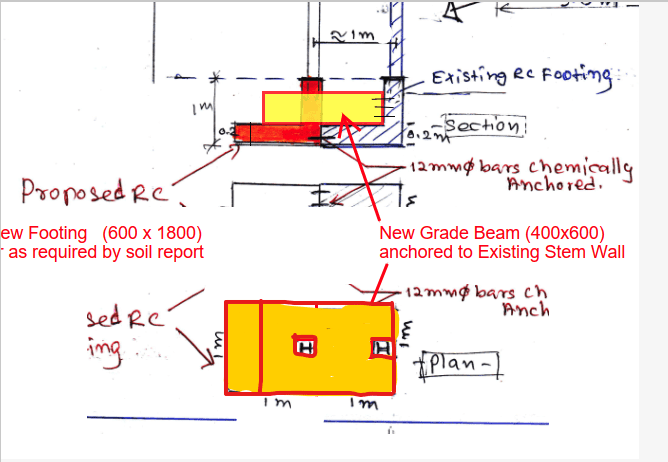Dear Structural Engineers
We are carrying out an upgrading of existing steel frame (having 2 levels) with a existing RC foundation & to convert it to a Warehouse space at the upper level.
Initially the Steel frame & foundation(footings) has been designed for a office space at upper level and now the client want to convert it to a warahouse to store some materials. storage loadings are not much high and the stored material weight to be not exceeding 500 Kg/m2 and also the cloumn/beam structure arrangement is 3m apart (in Plan) and the width(long span) of the building to be 9 meters.We worked out the factored design load for the upper level proposed composite steel deck slab and it to be around 10 KN/m2
The main beams were analysed and observed their capacity was OK but the Columns and the RCC footing sizes were not adequate for the additional load & BM.
Therefore we suggested the clinet to have an extra column in front of the existing columns with new footing and the combination of the 2 columns and the (exsiting+additonal) footing can safely carry the Load + BM. This arrangement will give a clear space without center columns as per the client's requirement at the ground level.
The Bearing capacity of soil not checked but by visual inspection of the excavated test pit and the prior knowledege of the bearing capacity of the surrounding sites, it seems that the B.C. to be approximately in between 150 to 200 KN/m2.Accordingly new footing.sizes worked out
Now I need to know that, when placing the new fotting, what will be the better option(As per the attached sketch)
Option (A) - new footing to be adjoined to the existing footing and reinforcement will be connected through chemical anchoring.Here the new column will located eccentric to the new footing.
or
Option (B) - New footing to be cast partially on top of the existing footing as shown
We are carrying out an upgrading of existing steel frame (having 2 levels) with a existing RC foundation & to convert it to a Warehouse space at the upper level.
Initially the Steel frame & foundation(footings) has been designed for a office space at upper level and now the client want to convert it to a warahouse to store some materials. storage loadings are not much high and the stored material weight to be not exceeding 500 Kg/m2 and also the cloumn/beam structure arrangement is 3m apart (in Plan) and the width(long span) of the building to be 9 meters.We worked out the factored design load for the upper level proposed composite steel deck slab and it to be around 10 KN/m2
The main beams were analysed and observed their capacity was OK but the Columns and the RCC footing sizes were not adequate for the additional load & BM.
Therefore we suggested the clinet to have an extra column in front of the existing columns with new footing and the combination of the 2 columns and the (exsiting+additonal) footing can safely carry the Load + BM. This arrangement will give a clear space without center columns as per the client's requirement at the ground level.
The Bearing capacity of soil not checked but by visual inspection of the excavated test pit and the prior knowledege of the bearing capacity of the surrounding sites, it seems that the B.C. to be approximately in between 150 to 200 KN/m2.Accordingly new footing.sizes worked out
Now I need to know that, when placing the new fotting, what will be the better option(As per the attached sketch)
Option (A) - new footing to be adjoined to the existing footing and reinforcement will be connected through chemical anchoring.Here the new column will located eccentric to the new footing.
or
Option (B) - New footing to be cast partially on top of the existing footing as shown




![[idea] [idea] [idea]](/data/assets/smilies/idea.gif)
